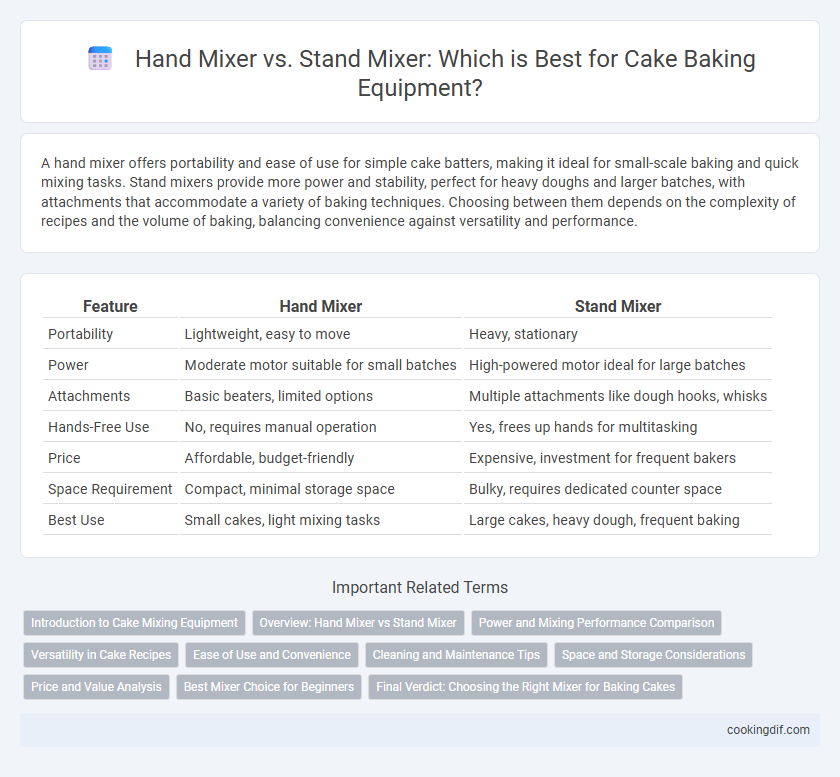A hand mixer offers portability and ease of use for simple cake batters, making it ideal for small-scale baking and quick mixing tasks. Stand mixers provide more power and stability, perfect for heavy doughs and larger batches, with attachments that accommodate a variety of baking techniques. Choosing between them depends on the complexity of recipes and the volume of baking, balancing convenience against versatility and performance.
Table of Comparison
| Feature | Hand Mixer | Stand Mixer |
|---|---|---|
| Portability | Lightweight, easy to move | Heavy, stationary |
| Power | Moderate motor suitable for small batches | High-powered motor ideal for large batches |
| Attachments | Basic beaters, limited options | Multiple attachments like dough hooks, whisks |
| Hands-Free Use | No, requires manual operation | Yes, frees up hands for multitasking |
| Price | Affordable, budget-friendly | Expensive, investment for frequent bakers |
| Space Requirement | Compact, minimal storage space | Bulky, requires dedicated counter space |
| Best Use | Small cakes, light mixing tasks | Large cakes, heavy dough, frequent baking |
Introduction to Cake Mixing Equipment
Hand mixers offer portability and ease of use, ideal for small to medium cake batters and quick tasks like whipping cream or beating eggs. Stand mixers provide powerful, consistent mixing with multiple attachments, suitable for heavy doughs and large-batch cake recipes requiring prolonged mixing times. Choosing between these mixers depends on batch size, mixing complexity, and kitchen space when preparing cake mixes.
Overview: Hand Mixer vs Stand Mixer
Hand mixers offer portability and ease of use, ideal for small to medium mixing tasks like whipping cream or beating eggs. Stand mixers provide more power and stability, suitable for heavy doughs and large batches, featuring various attachments for versatile baking needs. Choosing between a hand mixer and a stand mixer depends on the volume of baking and the types of recipes frequently prepared.
Power and Mixing Performance Comparison
Hand mixers typically offer power ranging from 150 to 300 watts, suitable for light to medium mixing tasks, while stand mixers provide 300 to 1000 watts or more, delivering superior torque for heavy-duty dough and large batches. Stand mixers feature larger motors and planetary mixing actions that ensure thorough ingredient incorporation and consistent batter texture. Power variations directly impact mixing efficiency, with stand mixers outperforming hand mixers in achieving smooth and evenly mixed cake batters faster.
Versatility in Cake Recipes
Hand mixers offer lightweight portability and precise control, making them ideal for simple cake batters and delicate folding tasks. Stand mixers provide powerful motors and multiple attachments, enabling extensive versatility to handle heavy doughs, whipped cream, and complex frosting techniques. For diverse cake recipes, a stand mixer ensures consistent results and saves time with its hands-free operation and multifunctional capabilities.
Ease of Use and Convenience
Hand mixers offer lightweight design and straightforward operation, making them ideal for quick tasks and small batches. Stand mixers provide hands-free mixing with powerful motors and multiple attachments, enhancing efficiency for larger or more complex recipes. The choice depends on kitchen space, frequency of use, and the type of baking projects undertaken.
Cleaning and Maintenance Tips
Hand mixers offer easier cleaning and maintenance due to their compact size and detachable beaters that can be rinsed or placed in the dishwasher. Stand mixers require more thorough cleaning, especially around the mixing bowl and attachments, and often need regular lubrication of the motor and gears for optimal performance. Choosing a hand mixer simplifies upkeep, while stand mixers demand a bit more care to maintain longevity and efficiency.
Space and Storage Considerations
Hand mixers offer a compact design that makes them ideal for kitchens with limited counter space, easily stored in drawers or small cabinets. Stand mixers, while bulkier and requiring dedicated countertop space, often come with spacious storage compartments for attachments, reducing clutter. Choosing between the two depends on balancing kitchen space constraints with the need for multi-functionality and storage convenience.
Price and Value Analysis
Hand mixers typically range from $20 to $100, offering affordable options for basic mixing tasks, making them ideal for occasional bakers or small batches. Stand mixers, costing between $200 and $500 or more, provide powerful motors and multiple attachments, delivering superior performance and versatility for frequent bakers and larger projects. Considering long-term value, stand mixers justify the higher price by enabling efficient mixing, kneading, and whipping, reducing preparation time and improving cake consistency.
Best Mixer Choice for Beginners
Hand mixers offer lightweight portability and simple controls, making them ideal for beginner bakers who primarily prepare smaller batches of cake batter. Stand mixers provide powerful motors and versatile attachments, suitable for users aiming to experiment with complex cake recipes and larger quantities. For novices, a hand mixer often represents the best balance of ease and functionality without the investment and space requirements of a stand mixer.
Final Verdict: Choosing the Right Mixer for Baking Cakes
A hand mixer offers portability and ease of use for small to medium cake batches, making it ideal for home bakers with limited space. Stand mixers provide powerful motor performance and versatility with multiple attachments, suitable for frequent bakers and complex cake recipes requiring heavy mixing. Selecting the right mixer depends on baking frequency, batch size, and storage availability to achieve optimal cake texture and consistency.
Hand Mixer vs Stand Mixer for equipment Infographic

 cookingdif.com
cookingdif.com